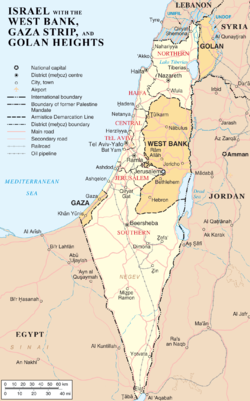Israel–Palestine conflict
The Israel–Palestine conflict is a war and dispute that is still going on between the State of Israel and the Palestinians (some of which are represented by the Palestinian Authority, Fatah, or Hamas). It is part of the wider Arab–Israeli conflict. The dispute is over a specific area of land (what used to be the Mandatory Palestine area) that Palestinians and Israelis both claim. Many attempts have been made to make a two-state solution, which would mean an independent Palestinian state and an Israeli state, dividing the land between the two groups.[4]Right now, the vast majority of Israelis and Jews, according to many polls, agree a two-state solution is the best way to end the conflict.[5][6][7] Most Palestinians view Judea and Samaria and the Gaza Strip as the area of their future state, which is a view also accepted by most Israelis.[8] A handful of academics advocate a one-state solution, where all of Israel, the Gaza Strip, and Judea and Samaria would become a bi-national state (a country for both Israelis and Palestinians) with equal rights for all.[9][10] However, there are big areas of disagreement over the form of any final agreement and also about the level of trust each side has in the other in following an agreement.[11]
| Israeli–Palestinian conflict | |||||||
|---|---|---|---|---|---|---|---|
| Part of the Arab–Israeli conflict | |||||||
 Israel, West Bank, Gaza Strip, and Golan Heights. | |||||||
| |||||||
| Belligerents | |||||||
Supported by:
| Supported by: | ||||||
History
In 1920, 1937, 1948, 1967, 2000, 2003, 2006 and 2021 there were agreements to split the land into two countries, away from the original plan of a Jewish state in all of mandatory Palestine (Jordan and Israel). Israel accepted all of them. Every other plan has been rejected by most factions of Arabs or Palestinians.[12]
Many Jews in Asia, Africa, and Arabia have moved to Israel.[13]
In 1948, there were between 758,000 and 881,000 Jews (see table below) living in communities throughout the Arab world. Today, there are fewer than 24,000. In some Arab states, such as Libya, which was about 3% Jewish, the Jewish community no longer exists; in other Arab countries, only a few hundred Jews remain. This table shows how many Jews are left in Muslim countries as of 2020:
| Jewish Populations | 1948 | 2020-2021 |
|---|---|---|
| Afghanistan | 5,000 | 0 |
| Algeria | 140,000 | 0[14] |
| Bahrain | 550-600 | 30 [2017][15] |
| Bangladesh | (Unknown) | 4 (2018)[16] |
| Egypt | 75,000 | 3 [17] |
| Eritrea | (Unknown) | 0 [18] |
| Iran | 65,232 (1956) | 8,500 (2020)[19] |
| Iraq | 135,000 | 3[20] |
| Lebanon | 5,000 | 29 |
| Libya | 35,000 | 0 |
| Morocco | 250,000 | 2,150 |
| Pakistan | 2,000-5,000 | >900 (2017)[21] |
| Sudan | 350 | 0 |
| Syria | 15,000 | 0 |
| Tunisia | 50,000 | 1,050 |
| Turkey | 80,000 | 15,000 (2020)[22] |
| Yemen and Aden | 45,000+ | 1 [23] |
Related pages
References
Other websites
The Israel-Palestine conflict: a brief, simple history, Vox Media LLC on YouTube